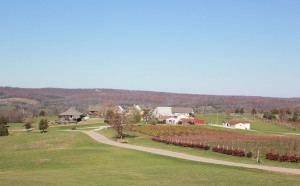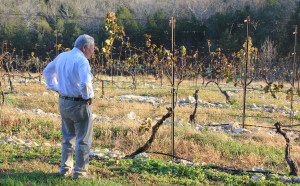Chaumette Winery Makes Chardonel Its Signature Grape
In the tasting room of Chaumette Vineyards there is a large mural depicting the history of owner Hank Johnson’s family going back to 1680’s. Johnson’s ancestors were Huguenots who fled France in the 1600’s. Today, Chaumette winery has retained many French influences in a part of Missouri that was the first French settlement west of the Mississippi River.
The featured wine at Chaumette is Chardonel, a hybrid grape that was developed by Cornell and Michigan State Universities and is the result of a cross between Seyval and Chardonnay. When made properly in the Midwest, Chardonel is very similar to Chardonnay.
Hank Johnson says some of his wine drinker customers cannot tell the difference between Chaumette Chardonel and Chardonnay. “Several of our supporters have brought our 2011 Reserve Chardonel, which is aged and fermented in French Oak barrels, to blind tastings. Nine of out of 10 people think our wine is California Chardonnay. The one person who guesses otherwise is usually the one who brought our Chardonel.”
Jennifer Johnson, C.S.W., Director of Marketing at Chaumette says, ‘Like Chardonnay, Chardonel is all about the winemaking process, as it can be made in any number of diverse styles, dry to sweet, oak aged or in stainless. When grown and made well, Chardonel and Chardonnay are indistinguishable.”
In 1993, Johnson built a rock glade vineyard, similar to those in the Chablis region of France where Chardonnay reigns. At Chaumette, Chardonel grows directly into a rocky, calcium rich soil reminiscent of Burgundy. “There’s no other vineyard like it that we know of in Missouri,” Johnson says.
The motivation for planting Chardonel came partially from Charlie Edson who worked for the Missouri State University Fruit Experiment Station in the early 90’s. Edson is now the winemaker at Bel Lago Vineyard and Winery in the Leelanau Peninsula of Michigan.
Chaumette focuses primarily on five estate grown varietals in its 30 acre vineyard: Chardonel, Chambourcin, Norton, Vignoles and Traminette. Other cultivars, like the French hybrid Couderc, are also grown on an experimental basis. Of the 10 wines on their current tasting menu, six are variations of the Chardonel grape, each crafted differently by their winemaker, Mark Baehmann.
80% of Chaumette’s wines are dry, which is unusual for Missouri and Midwest wineries. “It has been our endeavor to educate customers about what is good wine. Over the past three years, our top sellers have switched from sweeter styles to dry. We also understand that in the vast world of wine, there are phenomenal off-dry, semi-dry, semi-sweet and sweet wines and we do include examples of these styles in our portfolio. It is very important to us that no matter what style we produce, each wine is an excellent example of that specific wine style,” Jennifer Johnson says.
One style of wine that Hank Johnson favors is a Reserve Chardonel that is made in the image of a Burgundian Chardonnay. He explains the winemaking process for the Reserve Chardonel: “We like to start with juice that’s around 23 brix. We inoculate in temperature controlled stainless tanks and take the juice down to 10 brix before transferring to oak barrels. The secondary fermentation finishes in the barrel sur lie. Temperature control in the barrel is not as important because the main heat stage of fermentation has already passed at that point. Doing the malolactic fermentation in the barrel at a higher temperature works better for us. Battonnage is then performed in the barrel one time per week for six or seven months”
This process creates a creaminess in Chaumette’s Chardonel that is similar to big California Chardonnays. The flavor profile is complex with apple, a little pear, and a vanilla taste from the barrel. The diacetyl produced by the malolactic fermentation also produces a buttery finish. The reserve Chardonel sells for $20 to $22 a bottle.

Chaumette Vineyards and Winery, whose multifaceted business covers weddings, culinary school, wholesale, retail, villas and business retreats.
Of course, Chaumette Chardonel’s flavor is also the result of an interaction between sun, air, water and earth. All of Chaumette’s vines are grown on a Smart Dyson trellis system, which is highlighted in the book ‘Sunlight into Wine” by Dr. Richard Smart.
Johnson said Smart Dyson allows sprays, sunlight and air to penetrate to the fruit clusters evenly. This process also maximizes maturation and ripening and allows the citric, tartaric and malic acids in Chaumette’s grapes to closely mirror the acid levels of vinifera grapes. “To get Chardonnel to taste like Chardonnay, you have to grow the grape properly, the wine can take on a wildness if the work in vineyard is not done well,” Jennifer Johnson said.
Chaumette used mechanical harvesting at one time, but decided they would rather hand-pick. “You get some maceration of grape skins with mechanical harvesting,” he said. At Chaumette, the grapes go directly from the destemmer to an eight ton press. There is no crushing. “We’re doing a whole berry, but not a whole cluster, press,” Hank said. Chaumette uses a progressive cavity pump which Hank says is very gentle on his grapes. Hank says this delicate process also works well for Traminette because less of the linalool terpene is extracted and the wine does not take on a heavy Muscat aroma.
2012 was one of the most difficult years for Chaumette, Hank said. Bud break occurred on March 22, 2012, about three weeks earlier than normal. At this time, the shoots on the vines were out about 18 inches and the stems and fruiting structures were frozen off. But Hank said the vines adapted in ways he had never seem before. For example, some laterals had inflorescence and sprouts even emerged from scar tissue. The total overall crop was about a 40% of normal, but Traminette production was a complete loss.
Chaumette also makes a unoaked Chardonel which is fermented in stainless steel and vinified like a Pinot Gris with no oak.
 Wine is only one aspect of Chaumette’s business model. The winery is a multi-faceted enterprise with a wine club, restaurant, culinary school, gift shop and retail wine store. Chaumette also has nine rental villas with plans to expand to 24 units. April through November, Chaumette’s villas are full every weekend. On premise are also three wedding facilities for space for business retreats.
Wine is only one aspect of Chaumette’s business model. The winery is a multi-faceted enterprise with a wine club, restaurant, culinary school, gift shop and retail wine store. Chaumette also has nine rental villas with plans to expand to 24 units. April through November, Chaumette’s villas are full every weekend. On premise are also three wedding facilities for space for business retreats.
All guests also have access to meals planned by Executive Chef Adam Lambay, the pool, fitness center, spa services, hiking trails, and fishing on the property’s many lakes. Chaumette also offers team building activities that emphasize grape-growing, winemaking and a cooking school. All meals offered are aligned with Chef ‘s emphasis on locally-sourced ingredients with 90% of their ingredients coming from local farmers April-November.
Chaumette produces between 5,000 and 6,000 cases per year and their wine is carried in over 80 restaurants in Southeast Missouri, Southern Illinois and in St. Louis, Missouri.
 Rebecca is the owner of Bauerhaus Design, which specializes in building brands for Midwestern wineries. For more information visit Bauerhaus Design at www.bauerhaus.com
Rebecca is the owner of Bauerhaus Design, which specializes in building brands for Midwestern wineries. For more information visit Bauerhaus Design at www.bauerhaus.com
[wp_geo_map]




Hi Hank,
We met late Saturday night, you were gracious enough to extend your hospitality and offer my friend and I a ride back to our villa. I just wanted to thank you again. I know I can speak for everyone in that we could not have been happier to stay and experience all that Chaumette has to offer!
Wish you and the winery the best; hope to be back soon…
Thanks for everything,
Luke